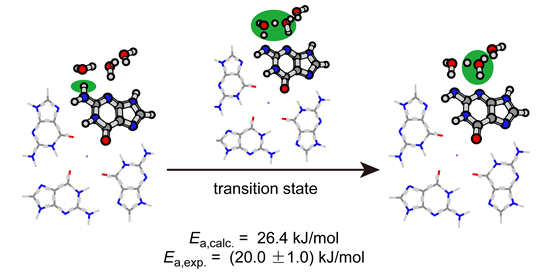摘要/Abstract

G-四链体传输空穴的特殊性质使其有望应用于发展分子电子器件.由于鸟嘌呤自由基阳离子(G·+)脱质子反应会中断空穴传递,影响传递效率,我们对G-四链体AG3(T2AG3)3中G·+脱质子过程展开了理论与实验的研究.根据瞬态紫外可见吸收光谱,确定了脱质子产物是G(N(2)-H)·;通过测量不同温度下G·+脱N(2)-H质子的速率常数,得到脱质子活化能为20.0±1.0 kJ/mol.进而,采用显性水和连续溶剂化模型相结合的方法模拟G-四链体中G·+脱质子环境,在M062X/6-31G(d)水平上得到了脱质子势垒(26.4 kJ/mol).结合实验值,理论计算的势能面描述了G-四链体中G·+脱N2-H的过程.这些结果为G-四链体在电子器件方面的应用提供了重要依据和指导.
关键词: G-四链体, 鸟嘌呤自由基阳离子, 脱质子反应, 活化能, 势能面
G-Quadruplex can be a promising candidate as molecular electronic device due to the ability of transferring hole. Extensive studies have reported that fast deprotonation of guanine radical cation (G·+) to form a neutral radical G(-H)· is the most important reaction in competition with hole transfer in DNA, hindering potential applications of DNA in molecular electronics. We thus carry out joint experimental and theoretical studies on deprotonation of G·+ in human telomere G-quadruplex AG3(T2AG3)3by using nanosecond laser flash photolysis and quantum chemical calculations. Upon 355 nm laser photolysis of Na2S2O8, instantaneously generated SO4·- radical oxidizes G base in the G-quadruplex to G·+. In the time-resolved absorption spectra that record the reaction of G-quadruplex with SO4·- at different temperatures, the transient absorptions of G(N(2)-H)· featured by absorption band at 640 nm are observed. It turns out that the G-quadruplex deprotonation product is G(N(2)-H)· and the deprotonation site is thereby validated to be amino proton. To obtain the activation energy of the G·+ deprotonation in G-quadruplex, the N(2)-H deprotonation rate constants at different temperatures varying from 280 to 300 K in steps 5 K are measured at a high G-quadruplex concentration, where the deprotonation has been proved to be the rate-limiting step in our previous work. Based upon Arrhenius equation, the deprotonation activation energy of G·+ in G-quadruplex is determined to be 20.0±1.0 kJ/mol. Further, the potential energy profile for the G·+ deprotonation in G-quadruplex is calculated at M062X/6-31G(d) level by carefully taking into account hydration environment of G·+ in G-quadruplex. The calculated energy barrier of 26.4 kJ/mol matches with the measured activation energy value, indicating the calculated potential energy profile can describe the deprotonation process of G·+ in the G-quadruplex. These theoretical and experimental results provide valuable dynamics information and mechanistic insights for potential applications of DNA structures in electronic device.
Key words: G-quadruplex, guanine radical cation, deprotonation reaction, activation energy, potential energy profile
PDF全文下载地址:
点我下载PDF
